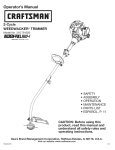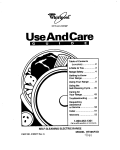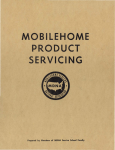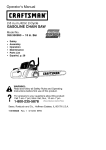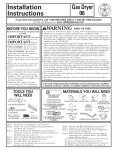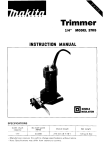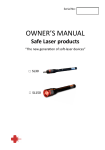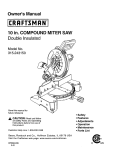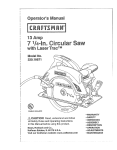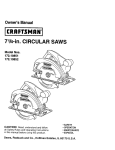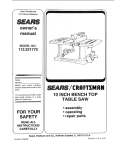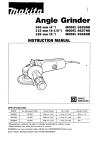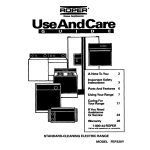Download Craftsman 320.27311 Operating instructions
Transcript
15 Amp 7 /4=Jn,Circular with Laser Trac T" Model No. 320.27311 irk, CAUTION Read, understand and fellow all Safety Rules and Operating instructions in this Manual before using this producL Sears, Roebuck and Co., Hoffman Estates, IL 60179 U°S.A. Visit our Craftsman website: www.craftsman.com I • WARRANTY • SAFETY • UNPACKING • DESCRIPTION ° OPERATION - ADJUSTMENTS • MAINTENANCE Warranty ....................................................................................... Page 2 Safety Symbols ..................................................................................... Page 3 Safety Instructions ................................................................................................ Pages 4 - 11 Glossary of Terms .................................................................................. Pages 11 - 12 Unpacking .............................................................................................. Pages 12 - 13 Description ............................................................................................................ Pages 13 - 15 Operation ......................................................................................................... Pages 15 - 25 Adjustments ................................................................................................. Page 26 - 27 Maintenance ............................................................................................................... Pages 27 - 29 Troubleshooting ......................................................................................................................... Page 30 Accessories ............................................................................................................................................ Page 30 Repair Parts ....................................................................................................................... Pages 3I - 34 Sears Repair Parts Phone Numbers ..................................... Back Cover ONE YEAR FULL WARRANTY PROFESSIONAL TOOL ON CRAFTSMAN If this Craftsman Professional Toot fails due to a defect in material or workmanship within one year from the date of purchase, RETURN IT TO ANY SEARS STORE OR PARTS AND REPAIR CENTER OR OTHER CRAFTSMAN OUTLET IN THE UNITED STATES FOR FREE REPAIR (OR REPLACEMENT IF REPAIR PROVES IMPOSSIBLE). This warranty does not include expendable parts such as lamps, batteries, bits or blades.. This warranty gives you specific legal rights, and you may have other rights, which vary from state to state.. Sears, Roebuck and Co_, Hoffman Estates, IL 60179 SAVE THESE INSTRUCTIONS! READ ALL INSTRUCTIONS! 2 Thepurpose ofsafetysymbols istoattractyourattention topossible dangers, Thesafetysymbols, andtheexplanations withthem,deserve yourcareful attention andunderstanding, Thesymbol warnings DONOTbythemselves eliminate anydanger, Theinstructions andwarnings theygivearenosubstitutes forproperaccident prevention measures, /_k WARNING: BE SURE to read and understand all safety instructions in this manual, including all safety alert symbols such as "DANGER", "WARNING" and "CAUTION", BEFORE using this saw. Failure to follow all instructions listed below may result in electric shock, fire and/or serious personal injury. SYMBOL //_ MEANING SAFETY ALERT SYMBOL: Indicates DANGER,WARNING,OR CAUTION.. May be used in conjunction with other symbols or pictographs. Failure to obey this safety warning WILL result in death or serious injury to yourself or to others. Always follow the safety precautions to reduce the risk of fire, electric shock and personal injury.. [ AWARNING Failure to obey this safety warning CAN result in death or 1 serious injury to yourself or to others.. Always follow the safety precautions to reduce the risk of fire, electric shock and personal injury. l!ix CAUTION I injury Failure toto yourself obey thisor safety MAYdamage,, result in Always personal others warning or property follow the safety precautions to reduce the risk of fire, electric shock and personal injury,, DAMAGE PREVENTION AND INFORMATION MESSAGES These inform user of important information and/or instructions that could lead to equipment or other property damage if not followed Each message is preceded by the word "NOTE:" as in the exampie below: NOTE: are not followed. Equipment WEAR YOUR and/or property damage may result if these instructions z_WARNtNG: The operation of any tool with a circular blade can result in foreign objects being thrown into your eyes, which can result in severe eye damage. Before beginning power tool operation, ALWAYS wear safety goggles or safety glasses with side shield and a full-face shield when needed. We recommend a Wide Vision Safety Mask for use over eyeglasses or standard safety glasses with side shield, available at Sears Stores or other Craftsman OuUets_ 3 I z_WARNING: BE SURE to read and understand all instructions in this manual before using this circular saw° Failure to follow all instructions may result in hazardous radiation exposure, electric shock, fire and!or serious personal injury. SAFETY PRECAUTIONS FOR LASERS This circular saw has a buitt-in laser light. The iaser is a Class ilia and emits output power of a maximum 2.,5mW and 635-665nm wavelengths. These lasers do not normally present an optical hazard,. However, DO NOT stare at the beam as this can cause flash blindness. The following label is on your tool,, It indicates where the saw emits the laser light, BE AWARE of the laser light location when using. ALWAYS MAKE SURE that any bystanders in the vicinity of use are made aware of the dangers of looking directly into the laser. _ 635,665nm Compl_s AVOID Laser OUtpUt,"<2.Stow wf61 Z! P...L,I*_S |ha [._et CFR paff_, Z_,40 lO a_ P_duct ;I.040,,1£ EY_POSURE LASI_I RADIATION DO _OT _A_'C IN3tO BEAM radiation is emiHed through this _perlure Z_WARNING: LASER LIGHT,, LASER RADIATION. Avoid Direct Eye Exposure. DO NOT stare into beam. Only turn laser beam on when the saw is on the workpiece. Class Iila laser, Z_WARNING: Use of controls, adjustments or performance of procedures other than those specified in this manual may result in hazardous radiation exposure,, i_WARNING: telescopes The use of optical instruments such as, but not limited to, or transits to view the laser beam will increase eye hazard,, , DO NOT remove or deface any product labels. Removing increases the risk of exposure to laser radiation, product labels 2. The laser beam can be harmful to the eyes. ALWAYS avoid direct eye exposure. DO NOT look directty into the laser beam output aperture during operation DO NOT project the laser beam directly into the eyes of others,, Turn laser on ONLY when making cuts, 3., Laser enhancing safety glasses are included to enhance the taser beam in bright light conditions, DO NOT wear these glasses if they interfere with the safe operation of this saw. 4., The laser on the circular saw is not a toy, ALWAYS keep out of the reach of children, The laser light emitted from this device SHOULD NEVER be directed towards any person for any reason, 5, BE SURE the laser beam is aimed at a workpiece (such as wood or rough coated surfaces) that does not have a reflective surface 4 SAFETYPRECAUTIONS FOR LASERS cont. 6 DO NOT use on surfaces such as sheet steel that have a shiny, reflective surface The shiny surface could reflect the beam back at the operator_. Be aware that laser light reflected off of a mirror or any other reflective surfaces can also be dangerous 7 ALWAYS turn the laser beam off when not in use. Leaving the tool on increases the risk of someone inadvertently staring into the laser's beam.. Z_ CAUTION : ALWAYS follow only the instructions contained in this manual when using this laser. Use of this feature in any manner other than what appears in this manual may result in a hazardous radiation exposure. 8..DO NOT attempt to modify the performance of this laser device in any way. This may result in a dangerous exposure to laser radiation.. 9. ALWAYS use only the accessories that are recommended by Sears for use with this product Use of accessories that have been designed for use with other laser tools could result in serious injury_ t 0.. For further information rega[ding lasers, refer to ANSI-Z136.1 The STANDARD FOR THE SAFE USE OF LASERS, available from the Laser Institute of America (407) 380-t 553 WORK AREA SAFETY Keep your work area clean and well lit,, Cluttered workbenches and dark areas invite accidents. 2 DO NOT operate power tools in explosive atmospheres, such as in the presence of flammable liquids, gases, or dust° Power tools create sparks which may ignite the dust or fumes. 3. Keep bystanders, children and visitors away while operating a power tool, Distractions can cause you to lose control 4. Make your workshop childproof with padlocks and master switches tools away when not in use. Lock 5. MAKE SURE the work area has ample lighting so you can see the work and that there are no obstructions that wilt interfere with safe operation BEFORE using your saw_ PERSONAL SAFETY 1.. KNOW your power tooto Read the operator's manual carefully Learn the saw's applications and limitations, as well as the specific potential hazards related to this tool 2. STAY ALERT, watch what you are doing and use common sense when operating a power tool.. 3. DO NOT use tool while tired or under the influence of drugs, alcohol or medication.. A moment of inattention white operating power tools may result in serious personal injury 4. DRESS properly,, DO NOT wear loose clothing or jewelry.. Pull back long hair Keep your hair, clothing, and gloves away from moving parts.. Air vents often cover moving parts and should also be avoided_ Loose clothing, jewelry or long hair can be caught in moving parts PERSONAL SAFETY cont. 5 AVOID accidental starting Be sure switch is in "OFF" position before plugging in, DO NOT carry tools with your finger on the switch Carrying tools with your finger on the switch or plugging in tools that have the switch in the "ON" position invites accidents, 6 REMOVE adjusting keys or wrenches before turning the tool "ON". A wrench that is left attached to a rotating part of the tool may result in personal injury, 7o Do not overreach. Keep proper footing and balance at all times. Proper footing and balance enables better control of the tool in unexpected situations 8, ALWAYS SECURE YOUR WORK, Use clamps or a vise to hold work when practical., It is safer than using your hand and frees both hands to operate tool 9 USE SAFETY EQUIPMENT° Always wear eye protection,, Dust mask, non-skid safety shoes, hard hat, or hearing protection must be used for appropriate conditions., I0_, DO NOT USE ON A LADDER or unstable support. Stable footing on a solid surface enables better control of the tool in unexpected situations, TOOL USE AND CARE SAFETY operating this saw° Failure to follow all instructions listed below may result in before f electric _WARNING: BE SURE to read and understand all instructions shock, fire and/or serious personal injury,, 1._ALWAYS use clamps or other practical ways to secure and support the workpiece to a stable platform. Holding the work by hand or against your body is unstable and may lead to loss of control, 2, DO NOT force the tool. Use the correct tool and blade for your application. The correct tool and blade will do the job better and safer at the rate for which it is designed 3 DO NOT use the toot if switch does not turn it "On" or "Off". Any tool that cannot be controlled with the switch is dangerous and must be repaired,, 4 DISCONNECT the plug from the power source before making any adjustments, changing accessories or storing the tool. Such preventive safety measures reduce the risk of starting the tool accidentally, 5 NEVER leave the tool running. ALWAYS turn it off. DO NOT leave the tool until it comes to a comp]ete stop 6 STORE idle tools out of the reach of children and other untrained Tools are dangerous in the hands of untrained users_, persons. 7, MAINTAIN tools with care. Keep cutting tools sharp and clean. Properly maintained tools with sharp cutting edges are less likely to bind and are easier to control, 8. CHECK for misalignment or binding of moving parts, breakage of parts, and any other condition that may affect the tool's operation If damaged, have the tool serviced before using Many accidents are caused by poorly maintained tools, 9. USE ONLY accessories that are recommended for this tool. Accessories that may be suitable for one tool may become hazardous when used on another tool., ELECTRICAL SAFETY or removing from the outlet. [ installing _WARNING: Do the not plug permit fingers to touch the terminals of plug when i, Double insulated tools are equipped with a polarized plug (one blade is wider than the other),This plug will fit in a polarized outlet only one way. if the plug does not fit fully in the outlet, reverse the plug_.If it still does not fit, contact a qualified electrician to install a polarized outieL Do not change the plug in any way 2. Double insulation[_ eliminates the need for the three-wire grounded power cord and grounded power supply system° Applicable only to Class !I (double-insulated) tools.. This circular saw is a double insulated tool., Cover of Grounded OiJllet Box ------ z_WARNING: © Double insulation DOES NOT take the place of normal safety precautions when operating this tool, 3_BEFORE plugging in the 1ool, BE SURE that the outlet voltage supplied is within the voltage marked on the tool's data plate, DO NOT use "AC only" rated tools with a DC power supply. 4, AVOID body contact with grounded surfaces, such as pipes, radiators, ranges and refrigerators. There is an increased risk of electric shock if your body is grounded 5. DO NOT expose power tools to rain or wet conditions or use power tools in wet or damp locations. Water entering a power tool will increase the risk of electric shock. 6 iNSPECT tool cords for damage, Have damaged tool cords repaired at a Sears Service Center. BE SURE to stay constantly aware of the cord location and keep it well away from the moving blade. 7 DO NOT abuse the cord° NEVER use the cord to carry the tool by or pull the plug from the outlet. Keep cord away from heat, oil, sharp edges or moving parts.. Replace damaged cords immediately. Damaged cords increase the risk of electric shock.. 1 1 EXTENSION CORDS Use a proper extension cord. ONLY use cords listed by Underwrilers Laboratories (UL). Other extension cords can cause a drop in line voltage, resulting in a loss of power and overheating of tool.. For this tool an AWG (American Wire Gauge) size of at least 14-gauge is recommended for an extension cord of 254£ or less in length Use 12-gauge for an extension cord of 50-ft. Extension cords 100-ft, or longer are not recommended. Remember, a smaller wire gauge size has greater capacity than a larger number (14-gauge wire has more capacity than 16-gauge wire; 12-gauge wire has more capacity than 14-gauge).. When in doubt use the smaller number When operating a power tool outdoors, use an outdoor extension cord marked "W-A" or "W". These cords are rated for outdoor use and reduce the risk of electric shock. Z_ CAUTION: Keep the extension cord clear of the working area. Position the cord so that it wilt not get caught on lumber, tools or other obstructions while you are working with a power tool. z_WARNING: Check extension cords before each use. If damaged replace immediately. Never use tool with a damaged cord since touching the damaged area could cause electrical shock, resulting in serious injury. SAFETY SYMBOLS FOR YOUR TOOL The label on your tool may include the following symbols. V............................................................................................... Volts A.................................................................................................... Amps Hz .......................................................................................................... Hertz W ...................................................................................................... Watts min .............................................................................................. Minutes ,-...................................................................................................... Alternating current ................................................................................... Direct current no ............................................................................................ No-load speed [] ............................................................................................ Class II construction, Double Insulated Jmin .......................................................................... Revolutions or Strokes per minute Z_........................................................................................... Indicates danger, warning or caution. It means attention! Your safety is involved.. SERVICE SAFETY I.. If any part of this saw is missing or should break, bend, or fail in any way; or should any electrical component fail to perform properly: SHUT OFF the power switch and remove the saw plug from the power source and have the missing, damaged or failed parts replaced BEFORE resuming operation. 2_.Tool service must be performed only at a Sears Parts and Repair Center. Service or maintenance performed by unqualified personnel could result in a risk of injury, 3,. When servicing a tool, use only identical replacement parts. Follow instructions in the maintenance section of this manual. Use of unauthorized pads or failure to follow maintenance instructions may create a risk of electric shock or injury. SAFETY RULES FOR CIRCULAR SAWS _Keep hands away from cutting area and blade,, Keep your second hand On the auxiliary handle or motor housing. If both hands are holding the saw, the blade cannot cut them° Z_ CAUTION: Blades coast after saw is switched off. I,KEEP your body positioned to either side of the saw blade and not in direct line with the saw blade. Kickback could cause the saw to jump backwards. (See "Kickback What Causes It and Ways to Help Prevent It" on pages 16 and I7).. 2 DO NOT reach underneath the work. The guard cannot protect you from the blade beneath the workpiece. _When sawing through a workpiece, the lower blade guard DOES NOT cover the blade on the underside of the workpiece (Pg. 14 Fig. 2). ALWAYS keep your hands and fingers away from the cutting area. 3 CHECK lower guard for proper closing BEFORE each use. DO NOT operate the saw if the lower guard does not move freely and close instantly. Never clamp or tie the lower guard in the open position.. If the saw is accidentalfy dropped, the lower guard may be benL Raise the lower guard with tile retracting lever The guard is operating properly when it moves freely, does not touch the blade or any other part in all angles and depths of cut, and readily returns to the closed position. 4. CHECK the operation and condition of the lower guard spring. If the guard and the spring are not operating properly, they MUST BE serviced before use. The lower guard may operate sluggishly, due to damaged parts, gummy deposits, or a buildup of debris DO NOT operate your saw until the damage has been repaired or replaced_ 5. The lower guard should be retracted manually ONLY for making special cuts, such as pocket or compound cuts, ALWAYS raise the lower guard by retracting its lever, As soon as the blade enters the material, the lower guard MUST be released. For all other sawing, the lower guard should operate automatically.. 6 ALWAYS make sure that the lower guard is covering the blade BEFORE placing the saw down on a work bench or floor. An unprotected moving blade will cause the saw to walk backwards, cutting whatever is in itspath. Make note of the time it takes for the blade to stop spinning after the switch is released 7 NEVER hold the piece being cut in your hands or across your legs. It is importantto support the workpiece property in order to minimize body exposure, blade binding, or loss of control. 8 HOLD TOOL by insulated gripping surfaces (handles) when performing an operation where the cutting tool may contact hidden wiring or its own cord. Contact with a "live" wire will make the exposed metal partsof the tool "live" and shock the operator.. 9..ALWAYS clamp the workpiece securely so it will not move when making the cut. I0. When ripping, ALWAYS USE a rip fence or straight edge guide. This improves the accuracy of the cut and reduces the chance of the blade binding. tl ALWAYS USE blades that have the correct size and shape (diamond vs, round) arbor holes. Blades that do not match the mounting hardware of the saw will run erratically and cause loss of control. 9 SAFETY RULES FORCIRCULAR SAWS conL 12, NEVER use damaged or incorrect blade washers or bolts. The blade washers and bolts were specially designed for your saw, for optimum performance and safely of operation. 13 NEVER cut more than one piece at a time. DO NOT STACK more than one workpiece on the worktable at a time. I4. AVOID awkward operations and hand positions cause your hand to move into the blade. 15, NEVER reach into the cutting where a sudden slip could path of the blade. Z_ WARNING: Use of this product can generate dust containing chemicals known to cause cancer, birth defects or other reproductive harm, Some examples of these chemicals are: • Lead from lead-based paints • Crystatline silica from bricks and cement and other masonry products, • Arsenic and chromium, from chemically treated lumber. Your risk from these exposures varies, depending upon how often you do this type of work.To reduce your exposure to these chemicals; • Work in a well-ventilated area • Work with approved safety equipment, such as those dust masks that are specially designed to filter out microscopic particles., Avoid prolonged contact with dust from power sanding, sawing, grinding, drilling and other construction activities, Wear protective clothing and wash exposed areas with soap and water. Allowing dust to get into your mouth, eyes, or lay on the skin may promote absorption of harmfut chemicals, z_ WARNING: Use of this tool can generate andlor disburse dust, which may cause serious and permanent respiratory or other injury° Always use NIOSH/OSHA approved respiratory protection appropriate for the dust exposure. Direct particles away from face and body. ADDITIONAL i RULES FOR SAFE OPERATION to follow all instructions listed below may result in electric shock, fire and/or _ WARNING: BE SURE to read and understand all instructfons_ Failure serious personal injury. 1. Know your power tool. Read operator's manual carefully. Learn the applications and limitations, as well as the specific potential hazards related to this tool, Following this rule will reduce the risk of e]ectric shock, fire or serious injury 2,, ALWAYS wear safety glasses or eye shields when using this saw° Everyday eyeglasses have only impact-resistant lenses; they are NOT safety glasses_ 3,, PROTECT your lungs. Wear a face mask or dust mask if the operation is dusty1 4 PROTECT your hearing. Wear appropriate personal hearing protection during use, Under some conditions and duration of use, noise from thisproduct may contribute to hearing lasso 5, ALL VISTORS AND BYSTANDERS MUST wear the same safety equipment that the operator of the saw wears 10 ADDITIONAL RULES FOR SAFE OPERATION cont. 6 INSPECT the tool cords periodically and if damaged have them repaired at your nearest Sears Service Center or other Authorized Service Facility. BE AWARE of the cord location° 7 ALWAYS check the tool for damaged parts. Before further use of the tool, a guard or other part that is damaged should be carefully checked !o determine if it will operate properly and perform its intended function Check for misalignment or binding of moving parts, breakage of parts, and any other condition that may affect the tool's operation. A guard or other part that is damaged should be properly repaired or replaced at a Sears Service center 8 INSPECT and remove all nails from lumber before sawing, 9oSAVETHESE INSTRUCTIONS, Refer to them frequently and use them to instruct others who may use this tool. tf someone borrows this tool, make sure they have these instructions also_ Spindle The shaft on which a blade or cutting tool is mounted_ Also called the Arbor Revolutions Per Minute (RPM) The number of turns completed by a spinning object in one minute Saw Blade Path The area over, under, behind or in frontof the blade, as it applies to the workpiece That area which wiUbe or has been cut by the blade Set The distance that the saw blade tooth is bent (or set) outward from the face of the blade Miter Cut A cutting operation made with the blade at any angle other than 900 to the fence Compound Miter Cut A compound miter cut is a cut made using a miter angle and a beve! angle at the same time. Cross cut A cutting or shaping operation made against the grain of the workpiece. Bevel Cut A cutting operation made with the blade at any angle other than 900 to the miter table Dado Cut A non-through cut which produces a square-sided notch or trough in the workpiece (requires special blade) Chamfer Cut A cut removing a wedge from a b!ock of wood so the end (or part of the end) is angled at other than 90& Ripping or Rip Cut A cutting operation along the length of the workpiece Freehand Cut Performing a cut without using a fence, miter gauge, fixture, work clamp, or other proper device to keep the workpiece from twisting or moving during the cut° Through Sawing Any cutting operation where the blade extends completely through the thicknessof the workpiece 11 Non-Through Cuts Anycutting operation where thebladedoesnotextend completely through the thickness oftheworkpiece, likeadadocut, Leading End Theendoftheworkpiece pushed intotoolfirst. Kerr Thematerial removed bytheblade ina through cutortheslotproduced bytheblade inanon-through orpartial cut Kickback Ahazard thatcanoccur whenthebladebinds orstalls,throwing theworkpiece back toward operaton Workpiece or Material Theitemonwhichthecutting operation isbeingdoneThesurfaces ofaworkpiece arecommonly referred toasfaces, endsandedges, Gum Asticky, sap-based residue fromwoodproducts, Resin Asticky, sap-based substance thathashardened+, Z_ WARNING: Your saw should NEVER be connected to the power source when you are assembling parts, making adjustments, installing or removing blades, cleaning or when it is not in use. Disconnecting the saw will prevent accidental starting, which could cause serious personal injury. 1,, The saw's cutting blade is installed at the factory. 2, The edge guide is force4itted into the top of the lid of the storage/carrying case. 3 The blade wrench is also force-fitted into the top of the lid of the case. The wrench is used when changing or installing a new blade. 4 A1soincluded and attached to the top of the bidof the case with a hook and loop strap is a pair of Laser enhancing safety glasses which are used to enhance the laser beam in bright light condition&, 5 There is a blade storage area in the bottom of the case where an extra bJade can be stored, 6 inspect the saw carefully to make sure that no breakage or damage has occurred during shipping, if any of the items mentioned are missing (refer to PARTS LiST on page 13), return the saw to your nearest Sears store or Craftsman outlet to have the saw replaced+ z_ WARNING: If any parts are broken or missing, DO NOT attempt to plug in the power cord or operate saw until the broken or missing parts are replaced. Failure to do so could result in possible serious injury° 12 PARTS LIST Fig. 3oEdge Guide (stored in case) 1[/ /11 4_ Blade Wrench (stored in case) I_ I _lU 5. Laser enhancing safety glasses O,' "_tf (for enhancing laser) 1. Saw 2. Blade (InstaLledat factory) 6oOperator's Manual KNOWYOUR CIRCULAR SAW (Fig. 2) NOTE: Before attempting to use your saw, familiarize operating features and safety requirements° yourself with all of the Your circular saw has a precision-built electric motor and it should only be connected to a 120-volt, 60-Hz AC ONLY power supply (normal household current)_.DO NOT operate on direct current (DC)_ This large voltage drop will cause a loss of power and the motor will overheat, If the saw does not operate when plugged into correct 120-volt, 60-Hz AC ONLY outlet, check the power supply. The saw has an 8-if., 2-wire power cord (no adapter needed}, This Circular Saw has the following features: t 15 Amp, 5200 RPM (no-load speed) motor° Provides power and torque for fast, sure cuts in wood, plywood, hardboard and wood-base materials_ 2 LaserTracTMThe unique, innovative feature for accurate, efficient cutting! 3 Built-in LED WORKLtGHT illuminates curling area for easy visibility This light stays "On" when saw is plugged into power source 4 Quick depth-of-cut adjustments with a maximum depth of cut: 2 318-in,thick at 90; 113hs-in, thick at 45 ° 5, Easy to read bevel cut scale adjusts from 0° to 56 ° bevel capacity, with a positive stop at 45° 6. Heavy duty, lightweight Magnesium blade guards for extra strength and durability 7_ Extended length trigger switch with soft-start for maximum control and comfort for either left or right hand. 8_ Oversized machined magnesium base provides stability for maximum control during sawing applications. 9 Soft-grip ergonomicaily designed contoured rear handle and front assist handle for positive gripping, control, balance and comforL 10 Includes Craftsman e 24 tooth carbide-tipped steel general purpose blade for fast, smooth cuts 13 This Circular Saw has the following tl. features (conL): Top mounted blade spindle lock for easy blade changes 12, Includes edge guide to help produce accurate cuts. 13, Built-in Sawdust 14, Permanently t5, Heavy-duty 16,, Includes ejection chute helps direct dust and chips away from operator. lubricated machined high-impact t00% ball bearings for smooth operation and long life. gearing for efficient power transmission, resistant carry/storage case on demand Fig. 2 Switch Rear Front Assist Handle Tdgger Switch Laser Light Aperture Work|ight Lower Blade Bevel Scale Guard Lever i Bevel Adjl Lever Base Guide g/ Clamping Screw Retaining Screw Lower Blade Guard Blade Slots for Edge Guide Front Assist Handle Spindle Lock Button Scale Housing Guard Lever Depth-of-Cut Adjustment Lever Base Loosen f _ghten 4, 14 Rating No-load Speed Blade Diameter 15 Amps 5200 RPM .... , , , 71/4-in. (184ram) Blade Arbor 5/8-in,, (t 6mm) Cutting Depth at 90 ° Cutting Depth at 45 ° 23/s-in. (60.38mm) Maximum Bevel Angle 56 o Input t20-V, 60Hz AC t Wl_-in. (46ram) Z_ WARNING: A 71/4-inch blade is the maximum blade capacity of your saw. A larger than 71t4-inch blade will come in contact with the blade guards_ Also, NEVER use a blade that is so thick that it prevents the outer blade washer from engaging with the flat side of the spindle, Blades that are too large or too thick can result in an accident causing serious injury, SAW BLADES All saw blades need to be kept clean, sharp and properly set in order to cut efficiently Using a dull blade places a heaw load on the saw and increases the danger of kickback° Keep extra blades on hand, so sharp blades are always available. Gum and wood pitch hardened on the blade slows the saw down Use gum and pitch remover, hot water or kerosene to remove them DO NOT use gasoline Fig. 3 Lower Guard in UP when a cut Blade level is position making BLADE GUARD SYSTEM (Fig_ 3) The lower blade guard, attached to your circular saw, is there for your protection and safety. It should NEVER be altered for any reason. If it becomes damaged or begins to return slowly or sluggishly, DO NOT operate your saw until the damage has been repaired or replaced. ALWAYS leave the guard in its correct operating position when using the saw, Z_ CAUTIO N: NEVER use the saw when the guard is not operating properly° The guard should be checked for correct operation before each use. If you drop your saw, check the lower blade guard and bumper for damage at all depth settings before using. NOTE:The guard is operating properly when it moves freely and then readily returns to the closed position. If for any reason your lower blade guard and bumper does not close freely, take the saw to your nearest Sears Repair Center for service before using it. 15 ., ,,, KICKBACK,,.WHAT CAUSES IT AND WAYS TO HELP PREVENT IT (Fig. 4) The Causes of Kickback \ Blade is Set Too Deep Correct Blade Depth Fig,, 4 _ KICKBACK 1, Kickback is a sudden reaction to a pinched, bound or misaligned saw blade, which causes an uncontrolled saw to lift up and out of the workpiece and toward the operator,, 2 When the blade is pinched or bound tightly by the keff closing down, the blade stalls and the motor reaction drives the unit rapidly back towards the operator,, Fig, 5 Righ_ 3 If the blade becomes twisted or misatigned in the cut, the teeth at the back edge of the blade can dig into the top sudace of ttTe wood, This causes the blade to climb out of the ken and jump back towardsthe operator 4, Sawing into knots or nails in the workpiece can cause Kickback, 5. Sawing into wet or warped lumber can cause Kickback (see Fig 5a),, 6, Forcing a cut, or not supporting the workpiece correctly can cause Kickback (see Fig. 5a). 7. Kickback is a result of tool misuse and/or incorrect operating procedures or conditions, it can be avoided by taking the proper precautions, on page I7 Wrong i 16 Ways to Help Prevent Kickback _ ALWAYS release trigger switch immediately if the blade binds or the saw stalls. Kickback could cause you to lose control of the saw. Loss of control can lead to serious lnjury_ 1. ALWAYS maintain a firm grip with both (see Fig, 6) hands on the saw and position your body and arms to allow you to resist Kickback forces, Kickback forces can be controlled by the operator, if the proper precautions are taken, 2, If the blade is binding, or when you are interrupting a cut for any reason, ALWAYS release the trigger and hold the saw motionless in the material until the blade comes to a complete stop, NEVER atlempt 1o remove the saw from the work or pull the saw backward while the blade is in motion, or Kickback may occur. CHECK and take corrective action to eliminate the cause of blade binding,, 3 Inspect the workpiece for knots or nails before cutting Never saw into a knot or nail. 4 DO NOT cut warped or wet lumber (see Fig 5a) 5 ALWAYS support large panels to minimize the risk of blade pinching and Kickback, Large panels tend to sag under their own weight(see Fig, 5a) Supports MUST be placed under the panel, one near the line of cut and one near the edge of the panel (see Fig. 5)_ 6. When restarting the saw in the workpiece, CENTER the blade in the kerr and check to be sure that the saw teeth are not engaged into the material if the saw blade is binding, it may walk up or Kickback from the workpiece when the saw is restarted, 7. DO NOT use a dul! or damaged blade, Unsharpened, improperly set, or gummed-up blades produce narrow kerr which causes excessive friction, blade binding and Kickback° 8, KEEP the blade at the correct depth setting. The depth setting should not exceed 1/4-inch below the material being cut (see Fig. 4). BE SURE that the blade depth and adjusting locking levers are tight and secure BEFORE making a cut:, If blade adjustment shifts while cutting it may cause binding and Kickback, 9 USE EXTRA CAUTION when making a "Pocket Cut" into existing walls or other blind areas The protruding blade may cut objects that can cause Kickback, 17 MAKING DEPTH-OF-CUT ADJUSTMENTS (Fig. 7) ALWAYS use the correct blade depth setting The correct blade depth setting for al! cuts should not be more than 1/4-inch below the material being cui (see Fig, 4), Allowing more depth will increase the chance of kickback and cause the cut to be rough, Your saw is equipped with a depth-of-cut scale that provides increased depth-of-cut accuracy, The depth-of-cut scale is located on the inside back of the upper blade guard Fig. 7 _th-of-cutScale b.RaisetheSaw Lowerthe Saw for adjusting TO SETTHE BLADE DEPTH (Fig. 7a) t Unplugthe saw Z_ WARNING: ALWAYS unplug saw before making any adjustments. Failure to unplug the saw could result in accidental starting which can cause serious personal injury° 2, Raise the depth-of-cut adjustment lever to loosen the base (see Fig, 7),. Fig. 7a 3,, Determine the desired depth of cut. 4. Locate the depth-of-cut scale on the back of the upper blade guard (see Fig, 7a)o 5_ Hold the base of the saw flat against the edge of the workpiece and then raise or lower the saw until the indicator mark on the bracket aligns with the notch on the blade guard at the desired depth-of-cut mark, 6 Tighten depth-of-cut adiustment lever Adjusting Bracket 18 USING THE LASER TRAC TM LASER LIGHT FEATURE (Fig° 8) /_ WARNING: LASER LIGHT. LASER RADIATIONo Avoid Direct Eye Exposure. DO NOT stare into beam. Only turn laser beam on when the saw is on the workpieceo Class itla laser° NOTE:Your circular saw has a built-in laser light.To activate laser light switch, saw must be plugged into power source. DO NOT turn the laser beam on until the saw is on the workpiece. 2,, Mark the line of cut on the workpiece 3,, Adiust the cutting angle and cutting depth as needed.. 4. Plug in the saw and push the laser switch forward to turn on the laser. ( 5. Align laser beam with line-of-cut (see Fig 8). 6. Squeeze the trigger switch and slowly push the saw forward using both hands..Keep the red laser beam on the line-of-cul. Always shut off the laser light when you are finished cutting. Fig. 8 /_ CAUTION: The Laser enhancing safety glasses that were included will enhance the laser light in bright light conditions_. DO NOT wear these glasses if they interfere with the safe operation of this saw. LED WORKLIGHT (Fig. 9) Your circular saw has a builtqn worklight for better visibility when cutting. This light is always "ON" when saw is plugged into power source 19 STARTING A CUT (Fig. 10) Z_ WARNING: ALWAYS clamp and support workpiece securely° ALWAYS maintain proper control of saw, Failure to clamp and support workpiece and loss of control of saw could result in serious injury° 1, ALWAYS use your saw with your hands positioned correctly, with one hand operating the trigger switch and the other on the front assist handle (see Fig. 10), Z_ WARNING: ALWAYS maintain proper control of the saw to make sawing safer and easier_ Loss of control of the saw could cause an accident resulting in possible serious injury_ 2 NEVER use the saw with your hands positioned as shown in Fig. 11 To Help Maintain Control: 3. ALWAYS support the workpiece near the cuL 4. ALWAYS support the workpiece so the cut wilt be on your right, 5, ALWAYS clamp the workpiece so it will not move during the cuL Place the workpiece with the good side down, I NOTE:The good side of the workpiece Fi is the side where appearance is important. 6, Before starting a cut, draw a guideline along the desired line of cut, then place the front edge of the saw base on that part of the workpiece that is solidly supported (see Fig, 10)_ 7 NEVER place the saw on the part of the workpiece that will fall off when the cut is made (see Fig_ II) 8, ALWAYS keep the cord away from the cutting area,, ALWAYS place the cord so it does not hang up on the workpiece when making a cuL 9 Hold the saw firmly with both hands (see Fig 10), Fig. 11 Z_ WARNING: tf the cord hangs up on the workpiece during a cut, release the trigger switch immediately.To avoid injury, unplug the saw and move the cord to prevent it from hanging up again. Using the saw with a damaged cord could result in serious injury or death_ if the cord has been damaged, have it replaced before using the saw again. 2O I I TO HELP MAINTAIN CONTROL cont.: 10. Squeeze the trigger switch to start the saw. ALWAYS let the blade reach full speed before you begin the cut into the workpiece. 11 When making a cut, ALWAYS use steady, even pressure. Forcing the saw causes rough cuts and could shorten the life of the saw or cause Kickback. I2. After completing your cut, release the trigger switch and allow the blade to come to a complete stop DO NOT remove the saw from the workpiece while the blade is moving. _When sawing through a workpiece, the lower blade guard DOES NOT cover the blade on the underside of the workpiece (see Fig. 3, page 15)=ALWAYS keep your hands and fingers away from the cutting area, Any part of your body coming in contact with the moving blade will result in serious injury, MAKING CROSS CUTS AND RIP CUTS (Figs, 12 and 12a) Z_ WARNING: ALWAYS clamp and support workpiece securely, ALWAYS maintain proper control of saw, Failure to clamp and support workpiece and loss of control of saw could result in serious injury, I. ALWAYS use your saw with your hands positioned correctly (see Fig,. 13).. Line o! Cut Fig. 12a 0° fndicator_ Z_ WARNING: ALWAYS maintain proper control of the saw to make sawing safer and easier, Loss of control of the saw could cause an accident resulting in possible serious injury. 2 When making cross or rip cuts, align your line of cut with the right side of the notch by the 0° indicator.. (see Fig. t 2a).. 3. Since the thickness of blades varies, MAKE ATRIAL CUT in scrap material along the guideline to determine how much, if any, you should offset the blade from the guideline to allow for the kerr of the blade to get an accurate cut.. 21 INTEGRATED CROSSCUT RULER Marked on the base across the front (see Fig, 12a) is a handy ruler for measuring repetitive cuts., It is marked 1-inch to the right of 0_and 5-inches to the left of 0°, MAKING RIP CUTS ALWAYS use a guide when making long or wide rip cuts with your saw You can use either a straight edge or use the edge guide that was included with your saw USING A STRAIGHT EDGE (Fig, 13) Z_ WARNING: ALWAYS clamp and support workpiece securely° ALWAYS ] maintain proper control of saw. Failure to clamp and support workpiece combined with loss of control of saw could result in serious injury. 1 I• You can make an efficient rip guide by clamping a straight edge to your workpiece,, Fig° 13 2 Carefully guide the saw along the straight edge for a straight rip cut (see Fig., 13). 3,,ALWAYS LETTHE BLADE REACH FULL SPEED, then carefully guide the saw into the workpiece, DO NOT bind the blade in the cut° Push the saw forward at a speed where the blade is not laboring, Slraight Edge INSTALLING AND USING THE EDGE GUIDE (Figs, 14 and 14a) Your saw comes with an edge guide that is 71/2-incheslong on the guide edge, It allows you to make accurate parallel cuts when trimming a workpiece,, It attaches to the saw's base The arm of the edge guide is stamped 0 to 7 inches in 118-inch increments and 18 centimeters in t-mm increments for easy adjustment of your cut, I, Unplug the saw, Z_ WARNING: ALWAYS unplug saw before making any adjustments, Failure to I unplug the saw could result in accidental starting which can cause serious personal injury. 1 2,, Position the edge guide so the arm with the inch increments is facing "up", Slide the arm of the edge guide into the mounting slots at the front of the saw's base (see Fig, 14), 3,_ Adjust the edge guide to the desired length of cut 4, Tighten the edge guide retaining screw, 5, Clamp and support the workpiece securely before making your cut 22 Fig, 14 INSTALLING AND USING THE EDGE GUIDE conto 6 Ptace the edge guide firmly against the edge of the workpiece (See Fig, t4a) Doing this will give you a true cut without pinching the blade., 7, BE SURE that the guiding edge of the workpiece is straight so you can get a straight cut., 8, ALWAYS LETTHE BLADE REACH FULL SPEED, then carefully guide the saw into the workpiece,, DO NOT bind the blade in the cut. Push the saw forward at a speed where the blade is not laboring. HOWTO SETYOUR BEVEL ANGLE Fig, 14a (Fig. 15) . Unplug the saw, Z_ WARNING: ALWAYS unplug saw before making any adjustments. Failure to unplug the saw could result in accidental starting which can cause serious personal inju_, 2. Loosen bevel adjustment lever (see Fig 15), Fig, 15 3 Raise the motor housing end of the saw until you reach the desired angle setting on the bevel scale. Bevel 4. Tighten the adjustment lever securely, 23 MAKING BEVEL CUTS (Figs. 16 and 16a) _Line of Cut 45 ° Indicator Fig. 16a Fig. 16 /_ WARNING: ALWAYS clamp and support workpiece securely. ALWAYS maintain proper control of saw. Failure to clamp and support workpiece and loss of control of saw could result in serious injury° 2. "four saw can be adjusted to cut at any angle between 0_ and 56 _. When making 45 ° bevel cuts, there is a notch in the saw base to help you line up the blade with the line of cut (see Fig, t6a), Align your line of cut with the feft side of the notch by the 45 o indicator when making 45° bevel cuts, 3, Since blade thicknesses vary and different angles require different settings, MAKE A TRIAL CUT in scrap material along the guideline to determine how much, if any, you should offset the blade from the guideline to alIow for the kerr of the blade to get an accurate cut 4, When making a bevel cut HOLD the saw FIRMLY with both hands (see Fig 16) 5,, Rest the front edge of the base on the workpiece, then squeeze the trigger switch to start the saw. ALWAYS let the blade reach full speed, then guide the saw into the workpiece 6,. After completing your cut, release the trigger switch and allow the blade to come to a complete stop in the cuL DO NOT remove the saw from the workpiece while the blade is moving It will damage your bevel cut and cause Kickback Z_ WARNING: If the blade comes in contact with the workpiece before it reaches full speed, it could cause the saw to kickback towards you, possibly resulting in serious injury. 24 MAKING POCKET CUTS (Fig. 17) ,_ WARNING: WARNING: ALWAYS adjust bevel setting to zero before making a pocket cut, Attempting a pocket cut at any other setting can result in a loss of control of the saw, which can result in serious injury, ! Adjust the bevel setting to zero, set the blade to the correct blade depth setting, then use the lower blade guard lever to swing the guard up.. 3 Z_ WARNING: ALWAYS raise the lower blade guard with the lever to avoid serious injury-. / J Fig. 17 2, While holding the lower blade guard up by the lever, firmly rest the front of the saw base flat against the workpiece with the rear handle raised so the blade does not touch the workpiece (see Fig t7) 3 Squeeze the trigger switch to start the saw. ALWAYS let the blade reach full speed, then slowly lower the blade onto the workpiece until the base is flat against the workpieceo AS the blade enters the material, you MUST release the lower blade guard lever. 4. After you complete the cut, release the trigger switch and allow the blade to come to a complete stop. After the blade has stopped, remove it from the workpiece_ If the corners of your pocket cut are not completely cut through, use a hand finishing saw to finish the corners f Leaving }'k WARNING: NEVERcould tie theresult lowerinblade guard in the raised position,, the blade exposed serious injury, 25 I POSITIVE i)_' BEVEL STOP 'four saw has a positive 0° bevel stop and it was adjusted at the factory to assure 0° angle of the saw blade for 90 ° cuts However, shipping can cause rnisalignment, HOWTO CORRECTTHE . Unplug the saw, 0 ° ANGLE SETTING (Fig. 18 and 18a) z_ WARNING: ALWAYS unplug saw before making any adjustments. Failure to unplug the saw could result in accidental starting which can cause serious personal injury. Carpente_,_square _,_. //Bevel _,._ Fig, 18 Saw Pointer Bevel Bevel Adjustment locking lever 2. Place saw in an upside down position on workbench.. 3 Use a carpenter's square to check the squareness of the saw blade to the base of your saw 4 If saw is not square, loosen bevel adjustment locking lever (see Fig.tS} Fig. 18a 5 Locate the slot (see Fig. 18a} on the bottom of the base that has a hex adjusting screw. Adjust this screw up or down with a 3mm Allen wrench or Hex Key (3/32_in.,) until blade is square to base., 6o Tighten bevel adjustment lever, lever if'k WARNING: securely tightened Attempting can result to make in serious cuts injury, without the bevel adjustment 26 locking WARNING: To ensure safety and reliability, all repairs - with the exception of the externally accessible brushes _ should be performed by a qualified service technician at a Sears Service Center, z_ WARNING: For your safety, ALWAYS turn off switch and unplug circular saw from the power source before performing any maintenance or cleaning. It has been found that electric tools are subject to accelerated wear and possible premature faiiure when they are used to work on fiber glass boats and sports cars, wallboard, spackling compounds or plaster. The chips and grindings from these materials are highly abrasive to electrical toot parts, such as bearings, brushes, commutators, etc. Consequently, it is not recommended that this tool be used for extended work on any fiberglass material, wallboard, spackling compound or plaster.. During any use on these materials, it is extremely important that the toot is cleaned frequently by blowing with an air jet.. during power tool operations, or when blowing dust. If operation is dusty, also wear Always wear safety goggles or safety glasses with side shields I i_ a dustWARNING: mask, ROUTINE products, MAINTENANCE penetrating oils, etc. come in contact with plastic parts. Chemicals can j damage, _ WARNING: DO NOTplastic, at any which time letmay brake fluids, gasoline,personal petroleum-based weaken or destroy result in serious injury. Periodic maintenance allows for long life and trouble-free operation. A cleaning, lubrication and maintenance schedule should be maintained. As a common preventive maintenance practice, follow these recommended steps: t. When work has been completed, clean the tool to allow smooth functioning of the toot over time. 2. Use clean damp cloths to wipe the tool_ 3 Check the state of all electrical cables.. 4. Keep the motor air openings free from oil, grease and sawdust or woodchips, and store tool in a dry place.. 5. Be certain that all moving parts that are exposed are well lubricated, particularly after lengthy exposure to damp and/or dirty conditions. 27 ] l CHANGING THE BLADE (Figs. 19 and 19a) z_ WARNING: BE SURE to wear protective work gloves while handling a saw blade.The blade can injure unprotected hands, 1. Unplug the saw_. /_ WARNING: To prevent personal injury, ALWAYS disconnect the plug from power source BEFORE assembling parts, making adjustments or changing blades. 2, 3. l I Place saw on its side on a fiat surface.. To loosen the depth-of-cut adjustment lever, raise the saw up all the way and tighten teven This gives you easier access to blade mounting area (see Fig,. 19a),. 4,, Place saw upright, on its base and on a flat surface (see Fig. 19a).. 5., To loosen the spindle clamping screw "A", depress the spindle lock button (see Fig.l 9). Place the blade wrench on the spindle clamping screw "A".. Move the wrench back and forth until you feel the spindle lock button depress further and it locks the blade in position so the spindle clamping screw can be removed. Keeping the spindle lock button firmly depressed, turn the spindle screw counterclockwise to remove.. Spindle Lock ig. 19 Button _"_...... Depth ofCut Adjustment Lever. Fig. 19a Outer "D" Washer / 28 "A" Spindle Clamping Screw ide Rotation teeth point up at front CHANGING THE BLADE cont. (Figs. 19 and 19a) 6.. Raise lower blade guard using the blade guard lever and hold it in the raised position for the next steps_. 7. Completely remove the spindle clamping screw "A" and the outer "D" washer and the blade (see Fig.. 19a).. 8.. The remaining washer is the inner bushing washer that fits around the spindle shaft and it does not need to be removed._ 9. Put a drop of oil onto the inner bushing washer and outer "D" washer where they will touch the blade.. 10 Place the new saw blade inside the lower blade guard, onto the spindle shaft and against the inner bushing. I NOTE:The teeth of the blade should point upward at the front of the saw as shown in (Fig. 19a). 1 I 1t ..Replace the "D" washer I2. Firmly hold down spindle lock button as you replace the spindle screw and hand tighten it in a clockwise direction.. Then use blade wrench to tighten the spindle clamping screw thoroughly., 13. Place blade wrench back in case.. NOTE: NEVER use a blade that is too thick to allow the "D" washer to engage with the flat side of the spindle,, LUBRICATION All of the bearings in this tool are lubricated with a sufficient amount of high-grade lubricant for the life of the tool under normal operating conditions. Therefore, no further lubrication is required. 29 1 tf the blade does not follow a straight line: • Teeth are dull. This is caused by hitting a hard object such as a nail, dulling teeth on one side.. The blade tends to cut to the side with the sharpest teeth.. • Base is out of line or bent. • Blade is bent. = Edge guide or straight edge is not being used.. if the blade binds or smokes • Blade is dull. - Blade is on baclmJards. , Blade is bent.. from friction: - Workpiece is not properly supported. ° Incorrect blade is being used.. " recommended Z_ WARNING: for thisThe tooluse might of attachments be dangerousor accessories and could result that are in serious not injury. Sears and other Craftsman outlets have a large selection of 7 1/4-inch Craftsman steel carbide-tipped blades designed for specific cutting applications. Contractor butk packs are also available. Sears and other Craftsman outlets also offer sawhorses, combination and framing squares, straight edges, edge guides, and a large assortment of clamps to help you with all your sawing needs. Visit your local Sears store or other Craftsman outlets or shop sears.corn/craftsman. 3O i % 31 71/4-in.CIRCULARSAW - MODEL NUMBER 320.27311 The Model Number will be found on the Nameplate Always mention the Model Number in air correspondenceregarding your tool, Item No. 1 Parts Nor .... 2780040000 Part Description Laser Set QtY1 2 3420489000 3 3420490000 4 5 3122920000 3122921000 Motor Housing Rear Cover 6 ......... 3320396000 3320395000 .........Right Handl e ....... Left Handle 7 8 : Gear Case 1 Upper !.............. Guard .................................. 1 1 9 3660170000 3121384000 Torsion Lens !0 3121341000 Fan Baffle tl 3400174000 Lock 5650017000 PiainWasher t3 5640151000 Boil 14 3121378000 Depth Ad}us!ing I5 3420334000 Moving Guard t6 3121379000 Moving Guard 17 t 8 3550225000 3550222000 Inner Flange Clamp 19 562015 20 21 3420184000 2800008000 22 5610094000 23 ......... 3121051000 24 ................ t2 t000 1 _1 Spring 1 1 1 Rod 1 GB96-85 6 A140 .......... I ' 1 Flange L,eve[ 1 1 Lever 1 ............ ! ........ 1 Screw 1 .... AdjustingBbck Brush Holder .... Sto#pe r ................................................ ] ........ 3121057000 Rubber ! 25 26 3121054000 3700255000 Spring Washer 27 28 5660030000 3550238000 circ!ips Fo[, Shaft Lock Shaft 29 3120560000 Button 30 3550240000 Lock 31 3660072000 Spring 32 3700539000 Epoxy 33 34 56t0048000 5620039000 Tapping Screw GB845-85 Screw GB818-85 U4xl0 35 3700262000 Wire 36 5610061000 Thread FormingScrew GB6560-86 5x30 37 5610042000 Tapping Screw GB845-85 ST42×I 9-F-H 12 38 5610053000 Tapping Screw GB845-854.2xg.5-F 3 39 5670008000 Spring Pin GB879-86 6x40 1 40 56t0062000 Thread FormingScrew 3 Tapping Screw ......................... GB6560-86 4X16 Ring ! ............. 2 3 1 1 ....................... ! ....... 1 1 Ring 1 1 Board 2 4.2X55-F Holder 32 2 3 1 GB6560-86 MSx40 1 71/4-in.CIRCULARSAW - MODEL NUMBER 320.27311 The Model Number will be found on the Nameplater Always mention the Model Number in atl correspondence regardingyour toot Item No. No. Part Description ....... ! QtY- ........... 2 5610057000 42 5700041000 Thread Forming Screw Oil fmpreging Bearing 43 5700015000 Bail' Bearing GB_276-94 44 45 3700780000 5680009000 46 3700540001 Sponge 1 47 3660071000 Spring 1 48 3700278000 Base Plate 1 49 3660069000 Spring 1 50 3122926000 45 ° Stop Block 1 5I 3703604Q0 52 53 .... PaNs 4t , Depth Bracket Rivet GB873-86 1 .............................. I' 1 I 62()'!:2RD 1 2 6×8 ........................... 1 q ................ Clamp .............. 3,500663000 5650053000 1 Ri,E.Fence Washer ...... 1 54 55 3400011000 3703605000 Wing Bolt 56 5660010000 57 3550253000 58 5680004000 59 3550235000 Gear 60 5700019000 61 3700281000 B'all'Bearing"_B Wave Washer 62 5660023000 63 5620088000 Circ!ipsFor Hole G'B8931i"_.86 35 Slotted Set Screw 64 4960023000 Carbon 65 66 3700586000 3810073000 67 3121381000 LED Cover 1 68 342031t Gear Case Cover 1 69 3121380000 Bevel Lever 1 70 ............... 3"i'2i"382000 LED Suppo_! ............................... 1 71 72 3121383000 2750827000 1 Support Piate E Ring GB896-86 Gear Shaft 1 9 1 1 ....P,!a.!.n Key GBI096-79 5xi4 : ..... 000 I T2.76-94 6003:2P, S ' 1 t i t .......... = 2 t Lining ........ Blade ........... LED Support2 Rotor 1 ....................... 1 1 73 ............................. 2'821947000 Tran.s!o.r.rn A.ssy .......... 74 5700013000 Ball Bearing GB T276-94 75 5620038000 Screw 4X8 1 76 436022 LED ! 77 282I 992000 Inner wire1 1 78 2740121000 Stator 79 282t,992000 Inner wire2 80 5650007000 t000 ...... 1 ' ........................ 1 6000-2Z 1 1 .....Sjqdng Washer GB93-87 4 33 . 1 ............ 3 7114-in.CIRCULARSAW- MODEL NUMBER 320.27311 The Model Number will be found on the Nameplate_ AIways mention the Model Number in all correspondence regarding your tool Item No, 81 ...........82 83 ...... Parts No, Part 3120563000 4870036000 Description Qty. ..... Dust Seal Switch ............ 1............. 1 4810002000 Power Cord & Plug ................. 1 84 3700367000 Cord Anchorage 1 85 5610093000 86 87 3121050000 88 .... ....... TaP,#!nq Screw Cord Guard 5640152000 1 .................... L_a,serButton 4930012000 .... Depth Support 91 5620032003,,, Screw 3X8 92 93 56500010.00 5650003000 94 5620006000 95 5650005000 5610058000 97 100 10.t 102 ..................................... 3 1 .................. ................ P...!ainWasher GB97.1-85 3 Spring Washer GB93-87 3 Hexagon Socket Screw GB70-85 ............... P.!.a.!nWasher GB97. t-85 4 Tapping Screw GB6560_86 M5X16 ................3,55o375o0o 4930013000 5620035000 .... 1..... Terminal 3700339000 .... 98 99 2 1 Bolt 3121385000 90 96 JiS M4x12 Nut M6X2P ............. F_.e_f_ptacle Screw GB818-85 !..... ..... M3x t 2 .... 2 ........... 3 2 2 ............. 1 1 3 M3.5x8 4 Base Plate Set 1 Gear Set Rotor Set 1 34 1 35 Get it fixed, at your home or ours! Your Home For repair - in your l_ome - of all major brand appliances, lawn and garden equipment, or heating and cooling systems, no matter wl_o made it, no matter who sold it! For the replacement parts, accessories and owner's manuals that you need to do-it-yourseff. For Sears professional installation of home appliances and items Eikegarage door openers and water heaters I_8004-MY*HOME:_;' (1_800-469-4663) w_,ev, sears_com A_nytime. day _" ntght (U S.A and Canada) \,¢,_v, sears, ca Our Home For repair of carry-in products ike vacuums lawn equipment, and electronics, call or go on-line for the nearest Sears Parts and Repair Center. 1-800-488_1222 Anytime.. day o; night (US A on_y) \_.sears COrn To purchase a protection agreement (USA) or maintenance agreemen, (Canada) on a product sewiced by Sears. t-800-827-6655 _u.sA) 14300-361-6665 (Canal) Para _dir se_sb de reparacbn a domicilio, y _era ordenar piezas 1-888-SU.,HOGAR"-' Au Canada pour seFclceen ffanqa_: 1.800.,LE.FOYER'._- (i-8&5-784-6427) V,'WW Se,3r_J C;3 (1-&.qO,532.6937) ,_-Sea..s_'_z._ LLC _ Registe.'ed_ Tr_dem_ik I :_" Tr_de:_,ark t r:,. _ervice Mark of $e_-s B__d'_ LLC 'q Marco RegisLtada 1 _z Marc_ dR F_bdca f-_; Ma;c,'_ de Servi¢:io de Seat _. Btand_. LLC _"1 Marque de _ommer_e f _'_:_Matq,ue 6.._pe_..dede Sears Brand_ LLC




































